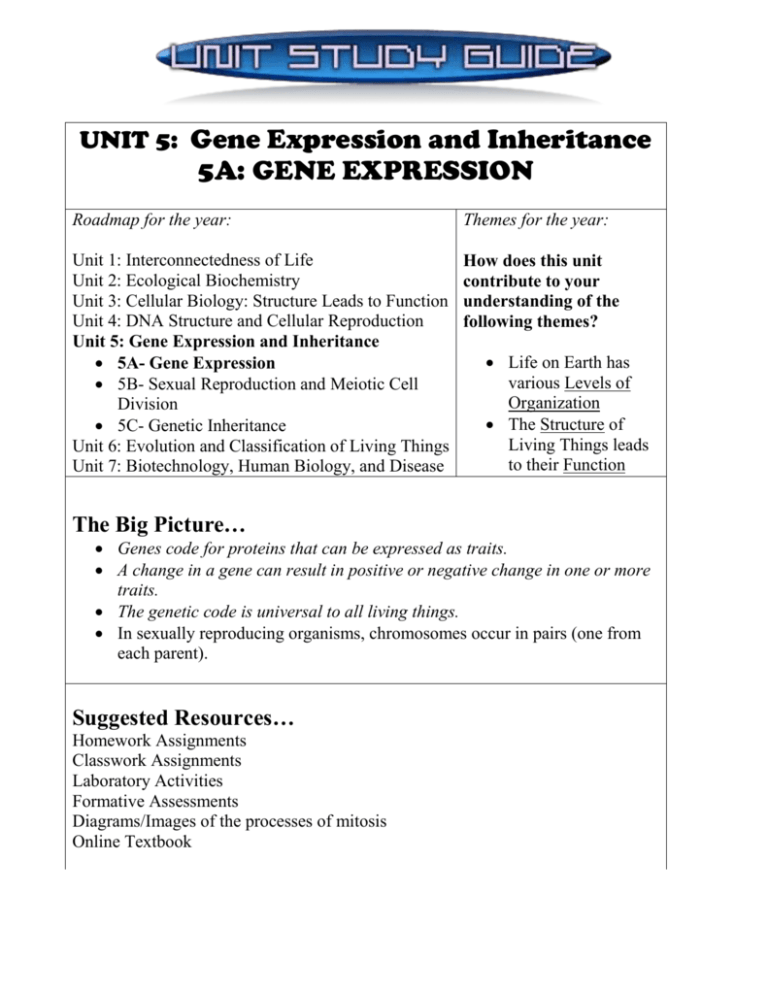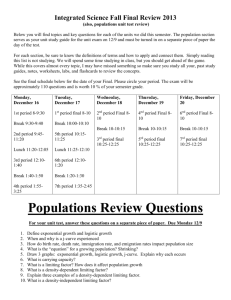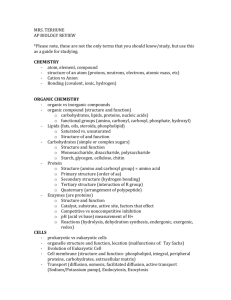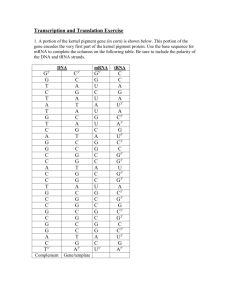Unit 5: Gene Expression and Inheritance 5A
advertisement

UNIT 5: Gene Expression and Inheritance 5A: GENE EXPRESSION Roadmap for the year: Themes for the year: Unit 1: Interconnectedness of Life Unit 2: Ecological Biochemistry Unit 3: Cellular Biology: Structure Leads to Function Unit 4: DNA Structure and Cellular Reproduction Unit 5: Gene Expression and Inheritance 5A- Gene Expression 5B- Sexual Reproduction and Meiotic Cell Division 5C- Genetic Inheritance Unit 6: Evolution and Classification of Living Things Unit 7: Biotechnology, Human Biology, and Disease How does this unit contribute to your understanding of the following themes? The Big Picture… Life on Earth has various Levels of Organization The Structure of Living Things leads to their Function Genes code for proteins that can be expressed as traits. A change in a gene can result in positive or negative change in one or more traits. The genetic code is universal to all living things. In sexually reproducing organisms, chromosomes occur in pairs (one from each parent). Suggested Resources… Homework Assignments Classwork Assignments Laboratory Activities Formative Assessments Diagrams/Images of the processes of mitosis Online Textbook By the conclusion of this unit, you should know the following: The gene is a unit of hereditary information that holds the code for synthesis of proteins/polypeptides or traits/parts of a trait. The term ‘genome’ can refer to the entire genetic makeup of a cell, organism or species. Though most of the genome is non-coding, the coding regions (“genes”) are what primarily determine the traits of organisms. Triplet codes found in a gene code for amino acids. The genetic code is considered to be universal. Structural and functional differences exist between DNA and the three types of RNA. Transcription uses the DNA gene code to produce a strand of RNA, while translation uses the mRNA to produce a protein/polypeptide. Enzymes are necessary for the processes of transcription and translation to occur. The mRNA codon chart can be used to predict the amino acid sequence of a polypeptide given the DNA or mRNA code. An amino acid can be coded for by more than one triplet code, but a single triplet can only code for a one type of amino acid (with the exception of the stop codons). All somatic cells in a multicellular organism contain the same DNA, as a result of mitotic cell division. Cells become specialized by the selective expression of certain genes. Changes in DNA (mutations) can occur spontaneously or due to the effect of mutagens. An altered gene may be passed on to every cell that develops from it. Addition, deletion, or substitution mutations can occur with individual nucleotides or large sections of a chromosome. Only those mutations which occur in gametes can be passed on to subsequent generations in a sexually reproducing species. By the conclusion of this unit, you should be able to do the following: Relate the terms DNA, chromosome, gene, protein, trait. Recognize the value of determining the sequence of a genome, as the “blueprint” of a cell, organism or species. Sequence the steps of how DNA’s code is transcribed into RNA through the process of transcription. Sequence the steps of how proteins are made from the mRNA transcript through the process of translation. Predict the location where the processes of protein synthesis take place in a eukaryotic cell. Compare and contrast the structures and functions of DNA and RNA Calculate the approximate number of amino acids which would be expected to be built into a polypeptide based on the number of nucleotides found in a gene or an mRNA molecule. Create analogies and/or role play the processes involved in protein synthesis. Use the mRNA codon chart to predict the amino acid sequence of a polypeptide which would be produced from a sample DNA strand. Explain how DNA can be altered by natural or artificial means to produce permanent changes in an organism, and how these changes can be helpful, harmful or neutral. Give several examples of causes of mutations. Explain how mutations can lead to a change in the protein for which the gene codes. Compare and contrast the effect of mutations in somatic cells vs. body cells. Gene Expression Vocabulary Words Found in the Glossary 1) Gene: 2) Protein: 3) Polypeptide: 4) Trait: 5) Amino Acid: 6) Ribosome: 7) Deoxyribonucleic Acid (DNA): 8) Ribonucleic Acid (RNA): 9) mRNA (messenger RNA): 10) tRNA (transfer RNA): 11) rRNA (ribosomal RNA: 12) Transcription: 13) Translation: 14) Codon: 15) Anticodon: 16) Mutation: 17) Mutagen: Words NOT Found in the Glossary (but may be within the textbook) 18) Triplet (as in triplet code): 19) Peptide Bond: 20) Uracil: 21) Protein Synthesis: 22) RNA Polymerase: 23) Complementary (as in base pairs): 24) Start Codon: 25) Stop Codon: 26) Insertion Mutation: 27) Deletion Mutation: 28) Substitution Mutation: 29) Cellular Specialization: 30) Coding (referring to DNA): 31) Non-coding (referring to DNA):











